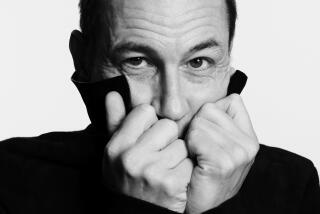Acting Presidential : In Role of Honest Abe, Player Brings History Alive for Students
- Share via
CHATSWORTH — Honest Abe, who had planned on bringing the wisdom of the 1860s to several hundred schoolchildren, instead got a lesson in 1990s morality: Somebody stole his clothes, top hat and all.
Actor John Werriner, who plays the role of the nation’s 16th president at school presentations, had his Abe Lincoln costume stolen from his car trunk, prompting the cancellation of his scheduled appearance last week at Ernest Lawrence Middle School.
The 35-year-old San Diego actor is hired by schools to supplement classroom history courses by appearing as Lincoln, telling “first-hand” stories of Lincoln’s boyhood, the Civil War and his campaign to end slavery.
“The whole point is to bring realism to a period of history,” said Lawrence Principal Tony Ventresca.
But Werriner bought a new hat and coat in time to make an appearance at the Chatsworth middle school on Monday, 187 years after Lincoln’s birth.
Speaking to about 700 students in six sessions through the day, Werriner paced back and forth a few times after being introduced to the audiences in the library, then dropped his voice, entering the role of the Great Emancipator.
He spoke first about his birth in a Kentucky log cabin, the death of his mother when he was 9, and moving to Indiana soon after.
His father moved the family to the free state, Lincoln said in a soft voice, partly because he strongly opposed slavery in such Southern states as Kentucky.
“But I have to be honest,” Lincoln continued.
He said the main reason the family moved was that white men, competing with cheaper slave labor, couldn’t find work in the South.
“My father couldn’t make any money there,” he said.
Near the end of the performance, in an account that hushed the teenagers, Lincoln told about a dream he had when he was president:
He was walking through the White House. Everyone was in a solemn mood, dressed in black, some crying. The house had been decorated with black curtains.
He asked a guard, “Who has died at the White House?”
The guard answered, “President Lincoln has been assassinated.”
Lincoln’s nightmare came true on April 14, 1965, when he was shot behind the right ear by John Wilkes Booth, a man from Maryland who favored slavery.
After he fired the fatal shot, Booth yelled something as he leaped to the stage to escape, which some witnesses said sounded like “Sic semper tyrannus,” Latin for “thus always to tyrants!” Lincoln died the next day.
But Lincoln told the students his death came only after he had accomplished his lifelong mission: freeing the slaves.
“In 1863 I did the most important thing,” Lincoln said.
That’s when he signed the Emancipation Proclamation, freeing the slaves in the Confederate states two years before the end of the bloody Civil War over whether the South could secede from the Union to preserve slavery.
During the last part of the presentation, the students’ concerns ranged from light-hearted questions, such as how many sons Lincoln had, to a thoughtful discussion of how the abolition of slavery became a pivotal point in American history.
“The response has been phenomenal,” Werriner--now himself again--said of his performances, pointing out that he was pleasantly surprised at the depth of the students’ questions.
“It’s difficult to get junior high school kids excited about anything these days,” he said.
But Billy Cameron, 14, enjoyed getting a lesson that was a little out of the ordinary.
“Instead of reading a book, [Lincoln] tells you more about how it was back then,” he said.
“It’s like talking to the real person,” added 13-year-old Sasha Gastelum.
Other students said they learned lessons that modern youth can use.
“[Lincoln] had nothing. He was born in a log cabin and then he lived in the White House,” noted Joshua Sterns, 13.
“Shows you can do anything if you put your mind to it,” he said.
More to Read
Get the L.A. Times Politics newsletter
Deeply reported insights into legislation, politics and policy from Sacramento, Washington and beyond. In your inbox twice per week.
You may occasionally receive promotional content from the Los Angeles Times.










